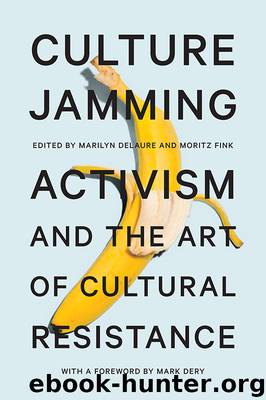Culture Jamming: Activism and the Art of Cultural Resistance by Marilyn Delaure & Moritz Fink & Marilyn Delaure & Moritz Fink & Mark Dery

Author:Marilyn Delaure & Moritz Fink & Marilyn Delaure & Moritz Fink & Mark Dery
Language: eng
Format: epub
Tags: art, Media Studies, LIT004020 Literary Criticism / American / General, Social Science, Popular Culture
Publisher: NYU Press
Published: 2017-02-28T01:02:32.139000+00:00
Who Do We Talk about When We Talk about Banksy?
Banksy is indisputably one of the most popular street artists today. His choice to work anonymously does not diminish the fact that a carefully constructed and expressive authorship is at work. In his introduction to the exhibition catalogue Fresh Air Smells Funny, Rik Reinking (2008) considers the author-persona Banksy to be a conscious and strategic promotional act (142), more than a means of preserving the anonymity that illegal graffiti writers must maintain. Banksy’s career began as a spray-can graffiti writer in and around Bristol in the 1990s. During the millennial years he switched to what is now his signature stencil technique, which had already been a stylistic feature of French street artist Blek le Rat since the 1980s. Banksy’s adaptation of this recognizable style quickly attracted a great deal of attention in the graffiti subculture, and he soon was organizing exhibitions and selling his art so successfully that Sotheby’s Cheyenne Westphal (2006), when interviewed by Max Foster for CNN’s Your World Today, called the emerging interest in other street artists that derived from his success “the Banksy effect.” In spite of his tremendous popularity, Banksy guards his anonymity cautiously and is the subject of ongoing rumors and speculation. Banksy comments on that hype in one of the pieces in his 2006 exhibition Barely Legal: a television screen shows a deliberate misquotation of Andy Warhol’s famous slogan “In the future, everyone will be world-famous for 15 minutes.” Banksy’s version reads, “In the future, everybody will be anonymous for 15 minutes.” In the digital age when artists and corporations court people to become online followers (and potential customers), Banksy interprets anonymity as freedom, a position consistent with the skepticism his art often expresses toward public surveillance.
Issues of authorship make it difficult to talk about Banksy’s art in terms of “originality”—his production strategies and visual style can easily be copied. That is also why some unauthorized works using a Banksy-esque style could not be identified as original. In 2008, several exhibits could not be auctioned at Sotheby’s because Banksy’s agency, Pest Control, refused to authenticate them (Collett-White 2008). Part of this ambiguity is rooted in Banksy’s style, which necessarily challenges the concepts of originality and authenticity. This is most explicit in the fake artifacts he smuggled into the exhibitions of various museums. In 2005, he hit the New York City Museum of Modern Art, the Metropolitan Museum of Art, the Brooklyn Museum, and the American Museum of Natural History in New York, as well as the British Museum in London with installations including a stuffed rat with a microphone and a backpack, or a fake cave painting depicting a caveman pushing a shopping cart. All fake exhibits were carefully integrated, mimicking the exhibition style and explanatory signs of the respective museums. A spokeswoman for the British Museum admitted that the Banksy’s caveman “looked very much in keeping with the other exhibits” (“Cave Art” 2005). The artifacts often remained unnoticed for a considerable amount of time, and the caveman in the British Museum even lasted several days.
Download
This site does not store any files on its server. We only index and link to content provided by other sites. Please contact the content providers to delete copyright contents if any and email us, we'll remove relevant links or contents immediately.
| Anarchism | Communism & Socialism |
| Conservatism & Liberalism | Democracy |
| Fascism | Libertarianism |
| Nationalism | Radicalism |
| Utopian |
The Secret History by Donna Tartt(18805)
The Social Justice Warrior Handbook by Lisa De Pasquale(12126)
Thirteen Reasons Why by Jay Asher(8767)
This Is How You Lose Her by Junot Diaz(6760)
Weapons of Math Destruction by Cathy O'Neil(6116)
Zero to One by Peter Thiel(5661)
Beartown by Fredrik Backman(5575)
The Myth of the Strong Leader by Archie Brown(5401)
The Fire Next Time by James Baldwin(5224)
How Democracies Die by Steven Levitsky & Daniel Ziblatt(5111)
Promise Me, Dad by Joe Biden(5077)
Stone's Rules by Roger Stone(5013)
100 Deadly Skills by Clint Emerson(4824)
A Higher Loyalty: Truth, Lies, and Leadership by James Comey(4822)
Rise and Kill First by Ronen Bergman(4682)
Secrecy World by Jake Bernstein(4618)
The David Icke Guide to the Global Conspiracy (and how to end it) by David Icke(4606)
The Farm by Tom Rob Smith(4421)
The Doomsday Machine by Daniel Ellsberg(4397)
